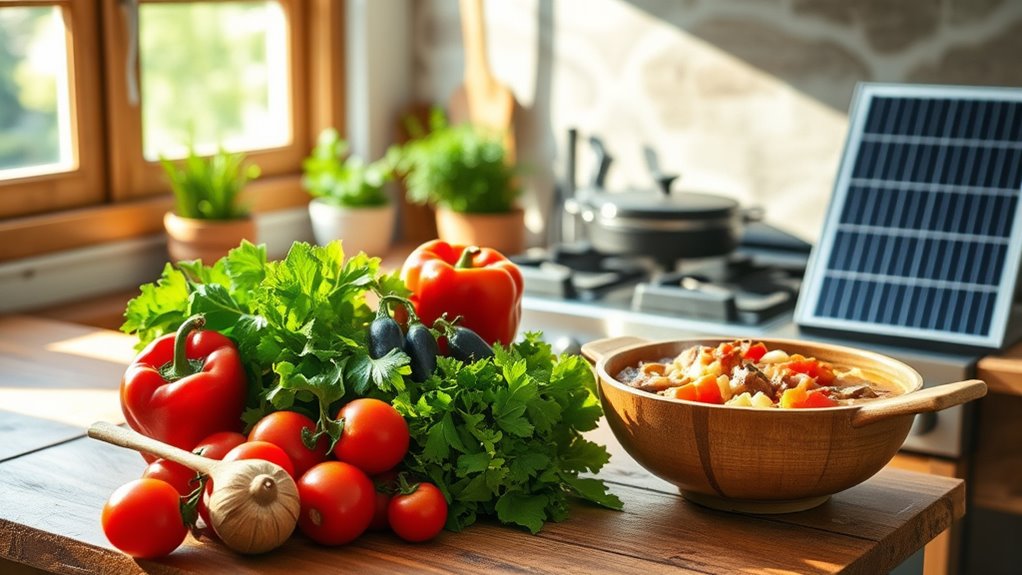To cook low-carbon, eco-friendly meals, choose local, seasonal ingredients and plant-based proteins like beans and tofu to reduce your environmental impact. Use energy-efficient appliances and methods, like induction stoves and batch cooking, to save energy. Make smarter choices such as reusing leftovers and avoiding resource-intensive foods like red meat. Small adjustments can markedly cut emissions. Keep exploring to discover more sustainable cooking tips that help you enjoy delicious, climate-conscious meals.
Key Takeaways
- Use local, seasonal produce and plant-based proteins to reduce transportation and environmental impacts.
- Choose energy-efficient appliances like induction stoves and convection ovens for cooking.
- Batch cook and reuse leftovers to minimize energy consumption and food waste.
- Incorporate ingredients farmed with fewer chemicals and lower energy inputs.
- Plan meals to optimize appliance use and utilize residual heat, lowering overall carbon footprint.

Cooking with the climate in mind isn’t just a trend; it’s an essential step toward reducing your environmental impact. By choosing sustainable ingredients, you can markedly lower your carbon footprint and support eco-friendly farming practices. Focus on fresh, local produce, which requires less transportation and packaging, and opt for plant-based proteins like beans, lentils, and tofu. These options are not only more sustainable but also nutrient-dense, helping you cook meals that are both eco-conscious and healthy. When shopping, prioritize organic and seasonal ingredients, as they tend to be farmed with fewer chemical inputs and less energy use. Incorporating these sustainable ingredients into your meals makes a tangible difference in reducing demand for resource-intensive foods like red meat and processed products.
Choose local, seasonal, plant-based ingredients to lower your carbon footprint and support sustainable farming practices.
Equally important is the way you prepare your meals. Investing in energy-efficient appliances, such as induction stoves, convection ovens, and high-efficiency refrigerators, can dramatically cut your household energy consumption. These appliances use less electricity or gas, reducing greenhouse gas emissions associated with cooking. When cooking, try to use methods that conserve energy—cover pots to retain heat, cook in batches to maximize appliance use, and avoid over-using the stove or oven. For example, using a pressure cooker or slow cooker can save substantial energy compared to traditional methods. Additionally, switching to microwave cooking for reheating or small meals is often more efficient than using the oven.
Another way to cut energy use is by being mindful of your cooking schedule. Batch cooking not only saves time but also minimizes the energy needed to heat multiple meals separately. Preparing larger quantities and storing leftovers reduces the frequency of cooking sessions, which translates into less energy consumption over time. When possible, utilize residual heat—turn off the stove a few minutes before your food is fully cooked to take advantage of the remaining warmth, further decreasing energy use. Moreover, choosing appliances with high contrast ratios can improve visibility and reduce the need for additional lighting, indirectly saving energy in your kitchen.
Incorporating these eco-friendly practices into your cooking routine creates a ripple effect—less energy consumption, fewer emissions, and a positive impact on the planet. It’s about making smarter choices in both the ingredients you select and the appliances you use. Over time, these small adjustments add up, helping you lead a more sustainable lifestyle without sacrificing the joy of cooking. By prioritizing sustainable ingredients and energy-efficient appliances, you’re not just preparing meals—you’re actively participating in the fight against climate change while enjoying delicious, guilt-free food.
Frequently Asked Questions
How Can I Reduce Food Waste While Cooking Eco-Friendly Meals?
To reduce food waste while cooking eco-friendly meals, focus on proper food storage to keep ingredients fresh longer. Plan meals carefully to buy only what you need, and use leftovers creatively. Incorporate composting techniques for food scraps like vegetable peels and coffee grounds, turning waste into nutrient-rich compost. This approach minimizes waste, supports sustainable practices, and helps you cook with a greener, more mindful mindset.
Are There Specific Kitchen Tools That Save Energy During Cooking?
Did you know that using energy-efficient appliances can cut your kitchen’s energy use by up to 30%? You should consider investing in appliances with high energy ratings and using reusable kitchenware like silicone lids or glass containers. These tools not only save energy but also reduce waste. By choosing energy-efficient appliances and reusable items, you make eco-friendly cooking easier and more sustainable, helping lower your carbon footprint.
What Are the Best Local Ingredients to Minimize Carbon Footprint?
You should focus on seasonal produce and regional sourcing to minimize your carbon footprint. By choosing ingredients that are in season locally, you reduce transportation emissions and support local farmers. Look for fresh, regional fruits, vegetables, and grains that are harvested nearby. This way, your meals stay eco-friendly, and you get the freshest ingredients. Opting for regional sourcing is an easy, effective way to cook more sustainably.
How Does Meal Planning Contribute to a Low-Carbon Diet?
Meal planning benefits your low-carbon diet by helping you choose sustainable ingredients and reducing waste. When you plan ahead, you can focus on seasonal, local foods, cutting down on transportation emissions. It also promotes dietary consistency, so you stick to eco-friendly habits. By organizing meals in advance, you avoid impulse purchases and minimize leftovers, making your eco-conscious efforts more effective and straightforward.
Can Plant-Based Recipes Be Satisfying for All Taste Preferences?
Aren’t you surprised how plant-based recipes can satisfy all taste preferences? Yes, they can, especially when you explore meat alternatives and use flavor enhancements like spices and herbs. By experimenting with textures and seasonings, you can create dishes that appeal to everyone’s palate. So, do you think trying new plant-based ingredients might just transform your meals into universally loved favorites? Give it a shot—you might be amazed!
Conclusion
By choosing low-carbon recipes, you become a hero on a mission to save the planet—one meal at a time. Every sustainable ingredient you select and eco-friendly method you embrace is a step toward a healthier Earth. Remember, your fork wields power—like a pen in your hand, it can rewrite the story of our future. So, cook consciously, eat responsibly, and let your actions ripple outward, turning small changes into a wave of positive change.









